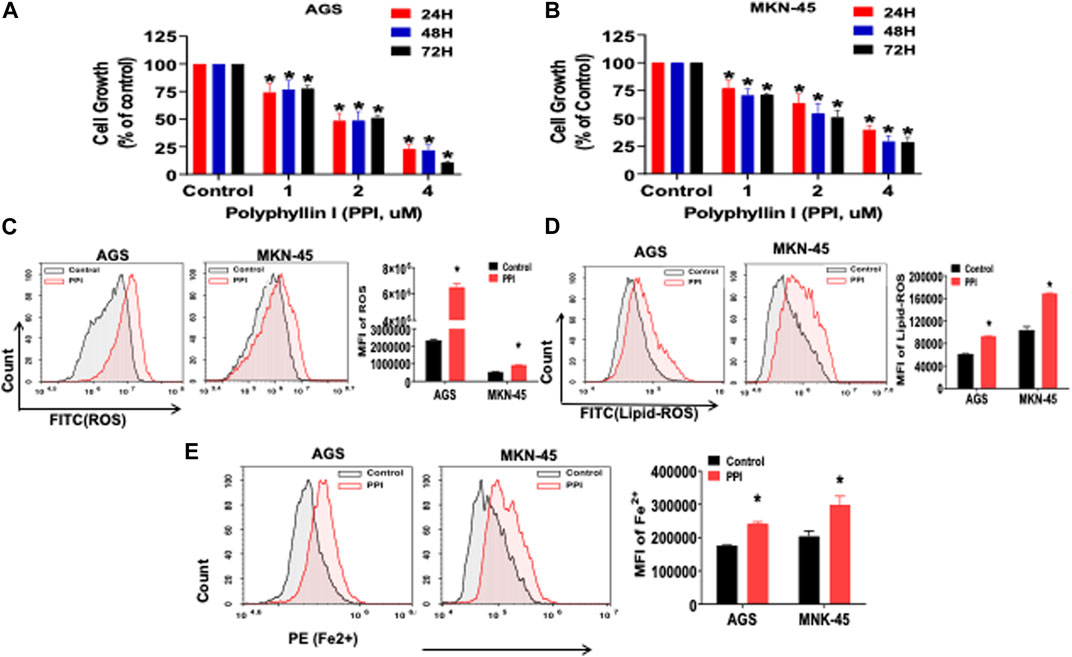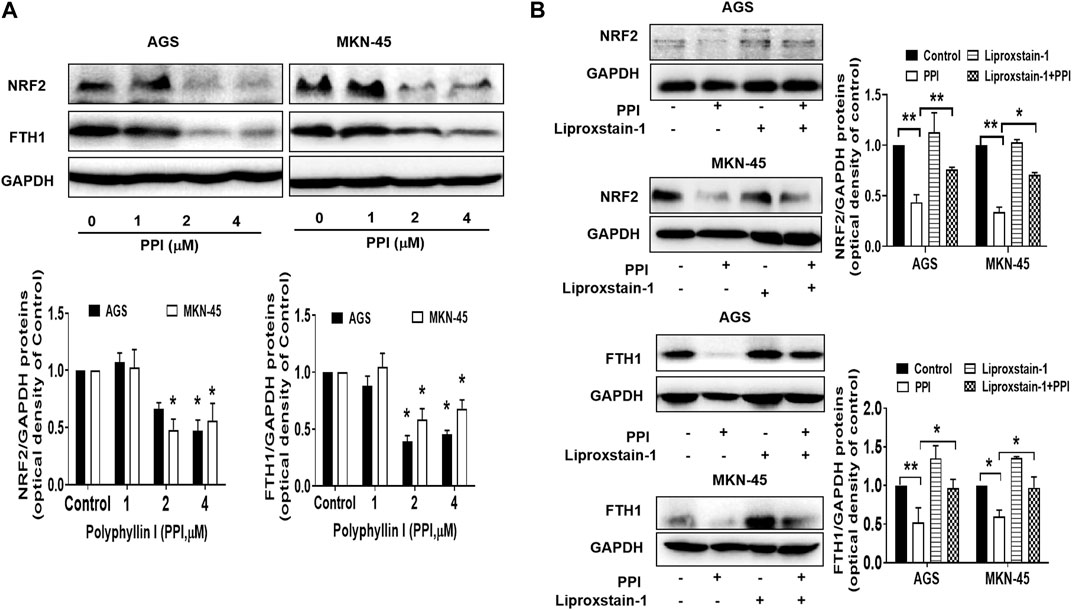Polyphyllin I suppresses the gastric cancer growth by promoting cancer cell ferroptosis
- 1Section of Immunology, The Second Affiliated Hospital of Guangzhou University of Chinese Medicine, Guangzhou, Guangdong, China
- 2Joint Immunology Program, Guangdong Provincial Academy of Chinese Medical Sciences, Guangzhou, Guangdong, China
A Corrigendum on
Polyphyllin I suppresses the gastric cancer growth by promoting cancer cell ferroptosis
by Zheng F, Wang Y, Zhang Q, Chen Q, Liang C-L, Liu H, Qiu F, Chen Y, Huang H, Lu W and Dai Z (2023). Front. Pharmacol. 14:1145407. doi: 10.3389/fphar.2023.1145407
There was an error in Figure 2 and Figure 6 as published. Figure 6A,C were disorganized because the GAPDH control for the same sample (PPI-treated MKN-45 cells) were unnecessarily shown twice. In addition, Figure 2E was already included in Figure 4A since both figures were derived from the same experiment. The original Figure 2E has been removed and accordingly replaced with the original Figure 2F, while Figures 6A,C have been combined into a single Figure 6A panel.

FIGURE 2. PPI suppresses cell growth and induces ferroptosis in the gastric cancer cells. (A, B) The cell growth (expansion) of AGS and MKN-45 cells after treatment with PPI (0, 1, 2, 3, 4 μM, for 24, 48 and 72 h, respectively) was examined using MTT assays. (C, D) The levels of cellular ROS and lipid peroxides (lipid-ROS) after the treatment with PPI (3 µM) for 24 h in AGS and MKN-45 cells were analyzed using a flow cytometer. (E) The levels of intracellular ferrous ions (Fe2+) in AGS and MKN-45 cells after PPI treatment for 24 h were quantified using a flow cytometer. Data are shown as mean ± SD while p values were determined using one-way ANOVA (*p < 0.05).

FIGURE 6. Effects of PPI on the expression of NRF2 and FTH1 in gastric cancer cells. AGS and MKN-45 cells were cultured and treated with PPI at various concentrations for 24 h, and then the protein levels of NRF2 and FTH1, without (A) or with (B) Liproxstain-1 treatment, were detected using Western blot assays. Data are presented as mean ± SD, while p values were determined using one-way ANOVA (*p < 0.05, and **p < 0.01, as indicated).
A correction has been made to the Results section, subsection PPI inhibits the growth of gastric cancer cells in vitro and induces their ferroptosis: “In addition, using a specific fluorescent probe, FerroOrange, we revealed that PPI increased the levels of ferrous ions in both AGS and MKN-45 cells (Figure 2E,F)” is corrected to “In addition, using a flow cytometer, we revealed that PPI increased the levels of ferrous ions in both AGS and MKN-45 cells (Figure 2E).”
A correction has been made to the Results section, subsection PPI downregulates NRF2 and FTH1 in the gastric cancer cells: “Using Western blot assays to detect ferroptosis-related proteins in the cancer cells after PPI treatment in vitro, we found that PPI downregulated the expression of both NRF2 (Figures 6A,B) and FTH1 (Figures 6C,D) in both AGS and MKN-45 cancer cells, indicating that PPI-induced ferroptosis in the gastric cancer cells is associated with its regulation of NRF2/FTH1 pathway.” is corrected to “Using Western blot assays to detect ferroptosis-related proteins in the cancer cells after PPI treatment in vitro, we found that PPI downregulated the expression of both NRF2 and FTH1 (Figure 6A) in both AGS and MKN-45 cancer cells, whereas Liproxstain-1 largely reversed this effect of PPI (Figure 6B), indicating that PPI-induced ferroptosis in the gastric cancer cells is associated with its regulation of NRF2/FTH1 pathway.”.
The corrected Figure 2 and Figure 6, and their captions appear below. The authors apologize for the errors and state that this does not change the scientific conclusions of the article in any way. The original article has been updated.
Publisher’s note
All claims expressed in this article are solely those of the authors and do not necessarily represent those of their affiliated organizations, or those of the publisher, the editors and the reviewers. Any product that may be evaluated in this article, or claim that may be made by its manufacturer, is not guaranteed or endorsed by the publisher.
Keywords: ferroptosis, gastric cancer, NRF2, polyphyllin I, anticancer drug
Citation: Zheng F, Wang Y, Zhang Q, Chen Q, Liang C-l, Liu H, Qiu F, Chen Y, Huang H, Lu W and Dai Z (2023) Corrigendum: Polyphyllin I suppresses the gastric cancer growth by promoting cancer cell ferroptosis. Front. Pharmacol. 14:1201715. doi: 10.3389/fphar.2023.1201715
Received: 07 April 2023; Accepted: 19 April 2023;
Published: 03 May 2023.
Edited and reviewed by:
Zhijie Xu, Central South University, ChinaCopyright © 2023 Zheng, Wang, Zhang, Chen, Liang, Liu, Qiu, Chen, Huang, Lu and Dai. This is an open-access article distributed under the terms of the Creative Commons Attribution License (CC BY). The use, distribution or reproduction in other forums is permitted, provided the original author(s) and the copyright owner(s) are credited and that the original publication in this journal is cited, in accordance with accepted academic practice. No use, distribution or reproduction is permitted which does not comply with these terms.
*Correspondence: Weihui Lu, d2VpaHVpLmx1QGd6dWNtLmVkdS5jbg==; Zhenhua Dai, emRhaTIwMDlAb3V0bG9vay5jb20=
 Fang Zheng
Fang Zheng Yeshu Wang
Yeshu Wang Qunfang Zhang
Qunfang Zhang Qiuyuan Chen
Qiuyuan Chen Chun-ling Liang
Chun-ling Liang Huazhen Liu
Huazhen Liu Feifei Qiu
Feifei Qiu Yuchao Chen
Yuchao Chen Haiding Huang1,2
Haiding Huang1,2 Weihui Lu
Weihui Lu Zhenhua Dai
Zhenhua Dai